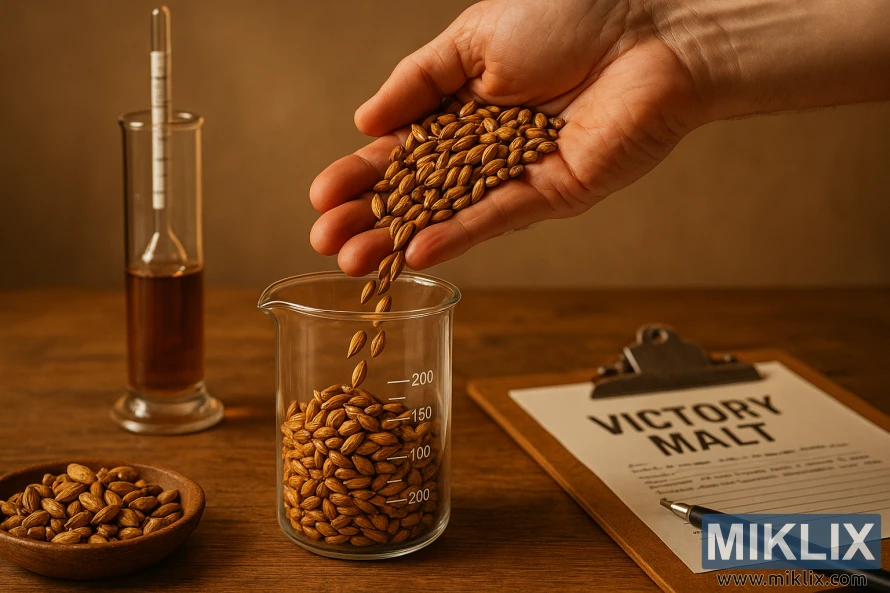Image: Victory Malt Recipe Formulation
Published: August 8, 2025 at 1:52:53 PM UTC
Last updated: September 27, 2025 at 4:15:19 PM UTC
Close-up of Victory Malt recipe formulation with grains poured into a beaker, brewing tools on wood, and warm light evoking a traditional brewhouse.
In this meticulously composed close-up, the image captures a moment of focused craftsmanship and scientific precision within the brewing process, centered around the use of Victory Malt. The scene unfolds on a warm-toned wooden surface, its grain and texture adding a tactile richness that complements the earthy hues of the malted barley. In the foreground, a hand is caught mid-motion, gently pouring golden-brown malt grains into a glass beaker already partially filled. The grains cascade with a soft rustle, their color and sheen suggesting freshness and quality. The beaker, marked with volume measurements up to 250 milliliters, stands as a symbol of control and accuracy, reinforcing the idea that brewing is as much a science as it is an art.
The hand itself is steady and deliberate, its gesture conveying care and experience. This is not a hurried action—it’s part of a ritual, a step in a larger process of recipe formulation where every gram of malt matters. The grains, likely roasted to a medium level, exhibit the signature characteristics of Victory Malt: a deep biscuit-like aroma, hints of toasted bread crust, and a subtle nuttiness that promises to enrich the body and flavor of the final brew. Their golden-brown hue glows under the ambient light, drawing the eye and anchoring the composition.
To the left of the beaker, a small dish holds additional malt grains, neatly arranged and ready for use. Beside it, a graduated cylinder filled with a dark amber liquid—possibly a malt extract or wort sample—adds a layer of complexity to the scene. The liquid’s color mirrors that of the grains, suggesting a direct relationship between ingredient and outcome. Its clarity and viscosity hint at a well-executed mash, where the sugars have been efficiently extracted and the malt’s character fully expressed.
On the right side of the frame, a clipboard rests on the table, its sheet labeled “VICTORY MALT” in bold letters. A pen lies beside it, poised for note-taking, suggesting that this is a moment of documentation as much as creation. The presence of written notes implies a methodical approach—perhaps a brewer refining a new recipe, adjusting malt ratios, or recording sensory observations. This blend of tactile engagement and intellectual rigor underscores the dual nature of brewing: intuitive and empirical, expressive and exacting.
The background is softly illuminated by a warm, diffused light that casts gentle shadows and enhances the depth of the scene. It evokes the ambiance of a traditional brewhouse, where natural materials and quiet focus define the workspace. The light wraps around the objects, highlighting their contours and textures, and creating a mood that is both inviting and contemplative. It’s the kind of light that suggests early morning or late afternoon—times when the brewhouse is quiet, and the brewer is alone with their thoughts and tools.
Altogether, the image is a visual ode to Victory Malt and its role in the brewing process. It celebrates the ingredient not just for its flavor contributions, but for its place in the larger narrative of beer-making. The careful measurement, the thoughtful arrangement of tools, and the warm atmosphere all speak to a philosophy of brewing that values detail, tradition, and the pursuit of excellence. In this moment, captured with clarity and grace, Victory Malt is more than a component—it’s a catalyst for creativity, a cornerstone of character, and a reflection of the brewer’s dedication to their craft.
The image is related to: Brewing Beer with Victory Malt

